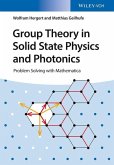95,99 €
95,99 €
inkl. MwSt.
Sofort per Download lieferbar

0 °P sammeln
95,99 €
Als Download kaufen

95,99 €
inkl. MwSt.
Sofort per Download lieferbar

0 °P sammeln
Jetzt verschenken
Alle Infos zum eBook verschenken
95,99 €
inkl. MwSt.
Sofort per Download lieferbar
Alle Infos zum eBook verschenken

0 °P sammeln
- Format: ePub
- Merkliste
- Auf die Merkliste
- Bewerten Bewerten
- Teilen
- Produkt teilen
- Produkterinnerung
- Produkterinnerung

Bitte loggen Sie sich zunächst in Ihr Kundenkonto ein oder registrieren Sie sich bei
bücher.de, um das eBook-Abo tolino select nutzen zu können.
Hier können Sie sich einloggen
Hier können Sie sich einloggen
Sie sind bereits eingeloggt. Klicken Sie auf 2. tolino select Abo, um fortzufahren.

Bitte loggen Sie sich zunächst in Ihr Kundenkonto ein oder registrieren Sie sich bei bücher.de, um das eBook-Abo tolino select nutzen zu können.
Density Functional Theory A concise and rigorous introduction to the applications of DFT calculations In the newly revised second edition of Density Functional Theory: A Practical Introduction, the authors deliver a concise and easy-to-follow introduction to the key concepts and practical applications of density functional theory (DFT) with an emphasis on plane-wave DFT. The authors draw on decades of experience in the field, offering students from a variety of backgrounds a balanced approach between accessibility and rigor, creating a text that is highly digestible in its entirety. This new…mehr
- Geräte: eReader
- mit Kopierschutz
- eBook Hilfe
- Größe: 10.83MB
Andere Kunden interessierten sich auch für
![Density Functional Theory (eBook, PDF) Density Functional Theory (eBook, PDF)]() David S. ShollDensity Functional Theory (eBook, PDF)95,99 €
David S. ShollDensity Functional Theory (eBook, PDF)95,99 €![Physics and Chemistry of Interfaces (eBook, ePUB) Physics and Chemistry of Interfaces (eBook, ePUB)]() Hans-Jürgen ButtPhysics and Chemistry of Interfaces (eBook, ePUB)66,99 €
Hans-Jürgen ButtPhysics and Chemistry of Interfaces (eBook, ePUB)66,99 €![Physics of Matter (eBook, ePUB) Physics of Matter (eBook, ePUB)]() George C. KingPhysics of Matter (eBook, ePUB)50,99 €
George C. KingPhysics of Matter (eBook, ePUB)50,99 €![Foundations of Solid State Physics (eBook, ePUB) Foundations of Solid State Physics (eBook, ePUB)]() Siegmar RothFoundations of Solid State Physics (eBook, ePUB)102,99 €
Siegmar RothFoundations of Solid State Physics (eBook, ePUB)102,99 €![Surface and Interfacial Forces (eBook, ePUB) Surface and Interfacial Forces (eBook, ePUB)]() Hans-Jürgen ButtSurface and Interfacial Forces (eBook, ePUB)83,99 €
Hans-Jürgen ButtSurface and Interfacial Forces (eBook, ePUB)83,99 €![Advanced Calculations for Defects in Materials (eBook, ePUB) Advanced Calculations for Defects in Materials (eBook, ePUB)]() Advanced Calculations for Defects in Materials (eBook, ePUB)133,99 €
Advanced Calculations for Defects in Materials (eBook, ePUB)133,99 €![Group Theory in Solid State Physics and Photonics (eBook, ePUB) Group Theory in Solid State Physics and Photonics (eBook, ePUB)]() Wolfram HergertGroup Theory in Solid State Physics and Photonics (eBook, ePUB)93,99 €
Wolfram HergertGroup Theory in Solid State Physics and Photonics (eBook, ePUB)93,99 €-
-
-
Density Functional Theory A concise and rigorous introduction to the applications of DFT calculations In the newly revised second edition of Density Functional Theory: A Practical Introduction, the authors deliver a concise and easy-to-follow introduction to the key concepts and practical applications of density functional theory (DFT) with an emphasis on plane-wave DFT. The authors draw on decades of experience in the field, offering students from a variety of backgrounds a balanced approach between accessibility and rigor, creating a text that is highly digestible in its entirety. This new edition: * Discusses in more detail the accuracy of DFT calculations and the choice of functionals * Adds an overview of the wide range of available DFT codes * Contains more examples on the use of DFT for high throughput materials calculations * Puts more emphasis on computing phase diagrams and on open ensemble methods widely used in electrochemistry * Is significantly extended to cover calculation beyond standard DFT, e.g., dispersion-corrected DFT, DFT+U, time-dependent DFT Perfect for graduate students and postdoctoral candidates in physics and engineering, Density Functional Theory: A Practical Introduction will also earn a place in the libraries of researchers and practitioners in chemistry, materials science, and mechanical engineering.
Dieser Download kann aus rechtlichen Gründen nur mit Rechnungsadresse in D ausgeliefert werden.
Produktdetails
- Produktdetails
- Verlag: Wiley-ISTE
- Erscheinungstermin: 15. Dezember 2022
- Englisch
- ISBN-13: 9781119840886
- Artikelnr.: 66994344
- Verlag: Wiley-ISTE
- Erscheinungstermin: 15. Dezember 2022
- Englisch
- ISBN-13: 9781119840886
- Artikelnr.: 66994344
- Herstellerkennzeichnung Die Herstellerinformationen sind derzeit nicht verfügbar.
David S. Sholl leads the Transformational Decarbonization Initiative at the Oak Ridge National Laboratory and is a Professor of Chemical & Biomolecular Engineering at the Georgia Institute of Technology.
Janice A. Steckel is a Physical Scientist at the United States Department of Energy, National Energy Technology Laboratory in Pittsburgh, Pennsylvania.
Janice A. Steckel is a Physical Scientist at the United States Department of Energy, National Energy Technology Laboratory in Pittsburgh, Pennsylvania.
1 What Is Density Functional Theory?
1.1 How to Approach This Book
1.2 Examples of DFT in Action
1.2.1 Ammonia Synthesis by Heterogeneous Catalysis
1.2.2 Embrittlement of Metals by Trace Impurities
1.2.3 Materials Properties for Modeling Planetary Formation
1.2.4 High Throughput/Big Data Case Study
1.3 The Schrödinger Equation
1.4 Density Functional Theory-From Wave Functions to Electron Density
1.5 Exchange- Correlation Functional
1.6 The Quantum Chemistry Tourist
1.6.1 Localized and Spatially Extended Functions
1.6.2 Wave-Function-Based Methods
1.6.3 Hartree- Fock Method
1.6.4 Beyond Hartree-Fock
1.7 What Can DFT Not Do?
1.8 Which DFT Code Should I Use?
1.9 Density Functional Theory in Other Fields
1.10 How to Approach This Book
2 DFT Calculations for Simple Solids
2.1 Periodic Structures, Supercells, and Lattice Parameters
2.2 Face-Centered Cubic Materials
2.3 Hexagonal Close-Packed Materials
2.4 Crystal Structure Prediction
2.5 Phase Transformations
Exercises
3 Nuts and Bolts of DFT Calculations
3.1 Reciprocal Space and k Points
3.1.1 Plane Waves and the Brillouin Zone
3.1.2 Integrals in k Space
3.1.3 Choosing k Points in the Brillouin Zone
3.1.4 Metals-Special Cases in k Space; DFT+U
3.1.5 Summary of k Space
3.2 Energy Cutoffs
3.2.1 Pseudopotentials
3.3 Numerical Optimization
3.3.1 Optimization in One Dimension
3.3.2 Optimization in More than One Dimension
3.3.3 What Do I Really Need to Know about Optimization?
3.4 DFT Total Energies-An Iterative Optimization Problem
3.5 Geometry Optimization
3.5.1 Internal Degrees of Freedom
3.5.2 Geometry Optimization with Constrained Atoms
3.5.3 Optimizing Supercell Volume and Shape
Appendix: Calculation Details
4 Thinking About Accuracy and Choosing Functionals for DFT Calculations
4.1 How Accurate Are DFT Calculations?
4.2 Choosing a Functional
4.3 Examples of Physical Accuracy
4.3.1 Benchmark Calculations for Molecular Systems-Energy and Geometry
4.3.2 Benchmark Calculations for Molecular Systems-Vibrational Frequencies
4.3.3 Crystal Structures and Cohesive Energies
4.3.4 Adsorption Energies and Bond Strengths
4.4 How to Use the Rest of this Book
5 DFT Calculations for Surfaces of Solids and Interfaces in Crystals
5.1 Importance of Surfaces
5.2 Periodic Boundary Conditions and Slab Models
5.3 Choosing k Points for Surface Calculations
5.4 Classification of Surfaces by Miller Indices
5.5 Surface Relaxation
5.6 Calculation of Surface Energies
5.7 Symmetric and Asymmetric Slab Models
5.8 Surface Reconstruction
5.9 Adsorbates on Surfaces
5.9.1 Accuracy of Adsorption Energies
5.10 Effects of Surface Coverage
5.11 Grain Boundaries in Solids
Exercises
Appendix: Calculation Details
6 DFT Calculations of Vibrational Frequencies
6.1 Isolated Molecules
6.2 Vibrations of a Collection of Atoms
6.3 Molecules on Surfaces
6.4 Zero-Point Energies
6.5 Phonons and Delocalized Modes
Exercises
7 Calculating Rates of Chemical Processes Using Transition State Theory
7.1 One-Dimensional Example
7.2 Multidimensional Transition State Theory
7.3 Finding Transition States
7.3.1 Elastic Band Method
7.3.2 Nudged Elastic Band Method and the Dimer Method
7.3.3 Initializing NEB Calculations
7.4 Finding the Right Transition States
7.5 Connecting Individual Rates to Overall Dynamics
7.6 Quantum Effects and Other Complications
7.6.1 High Temperatures/Low Barriers
7.6.2 Quantum Tunneling
7.6.3 Zero-Point Energies
Exercises
Appendix: Calculation Details
8 Equilibrium Phase Diagrams and Electrochemistry with Open Ensemble
Methods
8.1 Stability of Bulk Metal Oxides
8.1.1 Examples Including Disorder-Configurational Entropy
8.2 Stability of Metal and Metal Oxide Surfaces
8.3 Multiple Chemical Potentials and Coupled Chemical Reactions
8.4 DFT for Electrochemistry
Exercises
Appendix: Calculation Details
9 Electronic Structure and Magnetic Properties
9.1 Electronic Density of States
9.2 Local Density of States and Atomic Charges
9.3 Magnetism
Exercises
10 Ab Initio Molecular Dynamics
10.1 Classical Molecular Dynamics
10.1.1 Molecular Dynamics with Constant Energy
10.1.2 Molecular Dynamics in the Canonical Ensemble
10.1.3 Practical Aspects of Classical Molecular Dynamics
10.2 Ab Initio Molecular Dynamics: Gaussian Basis Sets in Non-Plane Wave
Codes
10.3 Applications of Ab Initio Molecular Dynamics
10.3.1 Exploring Structurally Complex Materials: Liquids and Amorphous
Phases
10.3.2 Exploring Complex Energy Surfaces
10.4 Time-Dependent Density Functional Theory
Exercises
Appendix: Calculation Details
11 Methods beyond "Standard" Calculations
11.1 Choosing a Functional (Revisited)
11.2 Estimating Uncertainties in DFT Results Using the BEEF Approach
11.3 DFT+X Methods for Improved Treatment of Electron Correlation
11.3.1 Dispersion Interactions and DFT-D and D2, D3, TS methods
11.4 Self-Interaction Error, Strongly Correlated Electron Systems, and
DFT+U
11.5 RPA
11.6 Larger System Sizes with Linear Scaling Methods and Classical Force
Fields
11.7 Conclusion
1.1 How to Approach This Book
1.2 Examples of DFT in Action
1.2.1 Ammonia Synthesis by Heterogeneous Catalysis
1.2.2 Embrittlement of Metals by Trace Impurities
1.2.3 Materials Properties for Modeling Planetary Formation
1.2.4 High Throughput/Big Data Case Study
1.3 The Schrödinger Equation
1.4 Density Functional Theory-From Wave Functions to Electron Density
1.5 Exchange- Correlation Functional
1.6 The Quantum Chemistry Tourist
1.6.1 Localized and Spatially Extended Functions
1.6.2 Wave-Function-Based Methods
1.6.3 Hartree- Fock Method
1.6.4 Beyond Hartree-Fock
1.7 What Can DFT Not Do?
1.8 Which DFT Code Should I Use?
1.9 Density Functional Theory in Other Fields
1.10 How to Approach This Book
2 DFT Calculations for Simple Solids
2.1 Periodic Structures, Supercells, and Lattice Parameters
2.2 Face-Centered Cubic Materials
2.3 Hexagonal Close-Packed Materials
2.4 Crystal Structure Prediction
2.5 Phase Transformations
Exercises
3 Nuts and Bolts of DFT Calculations
3.1 Reciprocal Space and k Points
3.1.1 Plane Waves and the Brillouin Zone
3.1.2 Integrals in k Space
3.1.3 Choosing k Points in the Brillouin Zone
3.1.4 Metals-Special Cases in k Space; DFT+U
3.1.5 Summary of k Space
3.2 Energy Cutoffs
3.2.1 Pseudopotentials
3.3 Numerical Optimization
3.3.1 Optimization in One Dimension
3.3.2 Optimization in More than One Dimension
3.3.3 What Do I Really Need to Know about Optimization?
3.4 DFT Total Energies-An Iterative Optimization Problem
3.5 Geometry Optimization
3.5.1 Internal Degrees of Freedom
3.5.2 Geometry Optimization with Constrained Atoms
3.5.3 Optimizing Supercell Volume and Shape
Appendix: Calculation Details
4 Thinking About Accuracy and Choosing Functionals for DFT Calculations
4.1 How Accurate Are DFT Calculations?
4.2 Choosing a Functional
4.3 Examples of Physical Accuracy
4.3.1 Benchmark Calculations for Molecular Systems-Energy and Geometry
4.3.2 Benchmark Calculations for Molecular Systems-Vibrational Frequencies
4.3.3 Crystal Structures and Cohesive Energies
4.3.4 Adsorption Energies and Bond Strengths
4.4 How to Use the Rest of this Book
5 DFT Calculations for Surfaces of Solids and Interfaces in Crystals
5.1 Importance of Surfaces
5.2 Periodic Boundary Conditions and Slab Models
5.3 Choosing k Points for Surface Calculations
5.4 Classification of Surfaces by Miller Indices
5.5 Surface Relaxation
5.6 Calculation of Surface Energies
5.7 Symmetric and Asymmetric Slab Models
5.8 Surface Reconstruction
5.9 Adsorbates on Surfaces
5.9.1 Accuracy of Adsorption Energies
5.10 Effects of Surface Coverage
5.11 Grain Boundaries in Solids
Exercises
Appendix: Calculation Details
6 DFT Calculations of Vibrational Frequencies
6.1 Isolated Molecules
6.2 Vibrations of a Collection of Atoms
6.3 Molecules on Surfaces
6.4 Zero-Point Energies
6.5 Phonons and Delocalized Modes
Exercises
7 Calculating Rates of Chemical Processes Using Transition State Theory
7.1 One-Dimensional Example
7.2 Multidimensional Transition State Theory
7.3 Finding Transition States
7.3.1 Elastic Band Method
7.3.2 Nudged Elastic Band Method and the Dimer Method
7.3.3 Initializing NEB Calculations
7.4 Finding the Right Transition States
7.5 Connecting Individual Rates to Overall Dynamics
7.6 Quantum Effects and Other Complications
7.6.1 High Temperatures/Low Barriers
7.6.2 Quantum Tunneling
7.6.3 Zero-Point Energies
Exercises
Appendix: Calculation Details
8 Equilibrium Phase Diagrams and Electrochemistry with Open Ensemble
Methods
8.1 Stability of Bulk Metal Oxides
8.1.1 Examples Including Disorder-Configurational Entropy
8.2 Stability of Metal and Metal Oxide Surfaces
8.3 Multiple Chemical Potentials and Coupled Chemical Reactions
8.4 DFT for Electrochemistry
Exercises
Appendix: Calculation Details
9 Electronic Structure and Magnetic Properties
9.1 Electronic Density of States
9.2 Local Density of States and Atomic Charges
9.3 Magnetism
Exercises
10 Ab Initio Molecular Dynamics
10.1 Classical Molecular Dynamics
10.1.1 Molecular Dynamics with Constant Energy
10.1.2 Molecular Dynamics in the Canonical Ensemble
10.1.3 Practical Aspects of Classical Molecular Dynamics
10.2 Ab Initio Molecular Dynamics: Gaussian Basis Sets in Non-Plane Wave
Codes
10.3 Applications of Ab Initio Molecular Dynamics
10.3.1 Exploring Structurally Complex Materials: Liquids and Amorphous
Phases
10.3.2 Exploring Complex Energy Surfaces
10.4 Time-Dependent Density Functional Theory
Exercises
Appendix: Calculation Details
11 Methods beyond "Standard" Calculations
11.1 Choosing a Functional (Revisited)
11.2 Estimating Uncertainties in DFT Results Using the BEEF Approach
11.3 DFT+X Methods for Improved Treatment of Electron Correlation
11.3.1 Dispersion Interactions and DFT-D and D2, D3, TS methods
11.4 Self-Interaction Error, Strongly Correlated Electron Systems, and
DFT+U
11.5 RPA
11.6 Larger System Sizes with Linear Scaling Methods and Classical Force
Fields
11.7 Conclusion
1 What Is Density Functional Theory?
1.1 How to Approach This Book
1.2 Examples of DFT in Action
1.2.1 Ammonia Synthesis by Heterogeneous Catalysis
1.2.2 Embrittlement of Metals by Trace Impurities
1.2.3 Materials Properties for Modeling Planetary Formation
1.2.4 High Throughput/Big Data Case Study
1.3 The Schrödinger Equation
1.4 Density Functional Theory-From Wave Functions to Electron Density
1.5 Exchange- Correlation Functional
1.6 The Quantum Chemistry Tourist
1.6.1 Localized and Spatially Extended Functions
1.6.2 Wave-Function-Based Methods
1.6.3 Hartree- Fock Method
1.6.4 Beyond Hartree-Fock
1.7 What Can DFT Not Do?
1.8 Which DFT Code Should I Use?
1.9 Density Functional Theory in Other Fields
1.10 How to Approach This Book
2 DFT Calculations for Simple Solids
2.1 Periodic Structures, Supercells, and Lattice Parameters
2.2 Face-Centered Cubic Materials
2.3 Hexagonal Close-Packed Materials
2.4 Crystal Structure Prediction
2.5 Phase Transformations
Exercises
3 Nuts and Bolts of DFT Calculations
3.1 Reciprocal Space and k Points
3.1.1 Plane Waves and the Brillouin Zone
3.1.2 Integrals in k Space
3.1.3 Choosing k Points in the Brillouin Zone
3.1.4 Metals-Special Cases in k Space; DFT+U
3.1.5 Summary of k Space
3.2 Energy Cutoffs
3.2.1 Pseudopotentials
3.3 Numerical Optimization
3.3.1 Optimization in One Dimension
3.3.2 Optimization in More than One Dimension
3.3.3 What Do I Really Need to Know about Optimization?
3.4 DFT Total Energies-An Iterative Optimization Problem
3.5 Geometry Optimization
3.5.1 Internal Degrees of Freedom
3.5.2 Geometry Optimization with Constrained Atoms
3.5.3 Optimizing Supercell Volume and Shape
Appendix: Calculation Details
4 Thinking About Accuracy and Choosing Functionals for DFT Calculations
4.1 How Accurate Are DFT Calculations?
4.2 Choosing a Functional
4.3 Examples of Physical Accuracy
4.3.1 Benchmark Calculations for Molecular Systems-Energy and Geometry
4.3.2 Benchmark Calculations for Molecular Systems-Vibrational Frequencies
4.3.3 Crystal Structures and Cohesive Energies
4.3.4 Adsorption Energies and Bond Strengths
4.4 How to Use the Rest of this Book
5 DFT Calculations for Surfaces of Solids and Interfaces in Crystals
5.1 Importance of Surfaces
5.2 Periodic Boundary Conditions and Slab Models
5.3 Choosing k Points for Surface Calculations
5.4 Classification of Surfaces by Miller Indices
5.5 Surface Relaxation
5.6 Calculation of Surface Energies
5.7 Symmetric and Asymmetric Slab Models
5.8 Surface Reconstruction
5.9 Adsorbates on Surfaces
5.9.1 Accuracy of Adsorption Energies
5.10 Effects of Surface Coverage
5.11 Grain Boundaries in Solids
Exercises
Appendix: Calculation Details
6 DFT Calculations of Vibrational Frequencies
6.1 Isolated Molecules
6.2 Vibrations of a Collection of Atoms
6.3 Molecules on Surfaces
6.4 Zero-Point Energies
6.5 Phonons and Delocalized Modes
Exercises
7 Calculating Rates of Chemical Processes Using Transition State Theory
7.1 One-Dimensional Example
7.2 Multidimensional Transition State Theory
7.3 Finding Transition States
7.3.1 Elastic Band Method
7.3.2 Nudged Elastic Band Method and the Dimer Method
7.3.3 Initializing NEB Calculations
7.4 Finding the Right Transition States
7.5 Connecting Individual Rates to Overall Dynamics
7.6 Quantum Effects and Other Complications
7.6.1 High Temperatures/Low Barriers
7.6.2 Quantum Tunneling
7.6.3 Zero-Point Energies
Exercises
Appendix: Calculation Details
8 Equilibrium Phase Diagrams and Electrochemistry with Open Ensemble
Methods
8.1 Stability of Bulk Metal Oxides
8.1.1 Examples Including Disorder-Configurational Entropy
8.2 Stability of Metal and Metal Oxide Surfaces
8.3 Multiple Chemical Potentials and Coupled Chemical Reactions
8.4 DFT for Electrochemistry
Exercises
Appendix: Calculation Details
9 Electronic Structure and Magnetic Properties
9.1 Electronic Density of States
9.2 Local Density of States and Atomic Charges
9.3 Magnetism
Exercises
10 Ab Initio Molecular Dynamics
10.1 Classical Molecular Dynamics
10.1.1 Molecular Dynamics with Constant Energy
10.1.2 Molecular Dynamics in the Canonical Ensemble
10.1.3 Practical Aspects of Classical Molecular Dynamics
10.2 Ab Initio Molecular Dynamics: Gaussian Basis Sets in Non-Plane Wave
Codes
10.3 Applications of Ab Initio Molecular Dynamics
10.3.1 Exploring Structurally Complex Materials: Liquids and Amorphous
Phases
10.3.2 Exploring Complex Energy Surfaces
10.4 Time-Dependent Density Functional Theory
Exercises
Appendix: Calculation Details
11 Methods beyond "Standard" Calculations
11.1 Choosing a Functional (Revisited)
11.2 Estimating Uncertainties in DFT Results Using the BEEF Approach
11.3 DFT+X Methods for Improved Treatment of Electron Correlation
11.3.1 Dispersion Interactions and DFT-D and D2, D3, TS methods
11.4 Self-Interaction Error, Strongly Correlated Electron Systems, and
DFT+U
11.5 RPA
11.6 Larger System Sizes with Linear Scaling Methods and Classical Force
Fields
11.7 Conclusion
1.1 How to Approach This Book
1.2 Examples of DFT in Action
1.2.1 Ammonia Synthesis by Heterogeneous Catalysis
1.2.2 Embrittlement of Metals by Trace Impurities
1.2.3 Materials Properties for Modeling Planetary Formation
1.2.4 High Throughput/Big Data Case Study
1.3 The Schrödinger Equation
1.4 Density Functional Theory-From Wave Functions to Electron Density
1.5 Exchange- Correlation Functional
1.6 The Quantum Chemistry Tourist
1.6.1 Localized and Spatially Extended Functions
1.6.2 Wave-Function-Based Methods
1.6.3 Hartree- Fock Method
1.6.4 Beyond Hartree-Fock
1.7 What Can DFT Not Do?
1.8 Which DFT Code Should I Use?
1.9 Density Functional Theory in Other Fields
1.10 How to Approach This Book
2 DFT Calculations for Simple Solids
2.1 Periodic Structures, Supercells, and Lattice Parameters
2.2 Face-Centered Cubic Materials
2.3 Hexagonal Close-Packed Materials
2.4 Crystal Structure Prediction
2.5 Phase Transformations
Exercises
3 Nuts and Bolts of DFT Calculations
3.1 Reciprocal Space and k Points
3.1.1 Plane Waves and the Brillouin Zone
3.1.2 Integrals in k Space
3.1.3 Choosing k Points in the Brillouin Zone
3.1.4 Metals-Special Cases in k Space; DFT+U
3.1.5 Summary of k Space
3.2 Energy Cutoffs
3.2.1 Pseudopotentials
3.3 Numerical Optimization
3.3.1 Optimization in One Dimension
3.3.2 Optimization in More than One Dimension
3.3.3 What Do I Really Need to Know about Optimization?
3.4 DFT Total Energies-An Iterative Optimization Problem
3.5 Geometry Optimization
3.5.1 Internal Degrees of Freedom
3.5.2 Geometry Optimization with Constrained Atoms
3.5.3 Optimizing Supercell Volume and Shape
Appendix: Calculation Details
4 Thinking About Accuracy and Choosing Functionals for DFT Calculations
4.1 How Accurate Are DFT Calculations?
4.2 Choosing a Functional
4.3 Examples of Physical Accuracy
4.3.1 Benchmark Calculations for Molecular Systems-Energy and Geometry
4.3.2 Benchmark Calculations for Molecular Systems-Vibrational Frequencies
4.3.3 Crystal Structures and Cohesive Energies
4.3.4 Adsorption Energies and Bond Strengths
4.4 How to Use the Rest of this Book
5 DFT Calculations for Surfaces of Solids and Interfaces in Crystals
5.1 Importance of Surfaces
5.2 Periodic Boundary Conditions and Slab Models
5.3 Choosing k Points for Surface Calculations
5.4 Classification of Surfaces by Miller Indices
5.5 Surface Relaxation
5.6 Calculation of Surface Energies
5.7 Symmetric and Asymmetric Slab Models
5.8 Surface Reconstruction
5.9 Adsorbates on Surfaces
5.9.1 Accuracy of Adsorption Energies
5.10 Effects of Surface Coverage
5.11 Grain Boundaries in Solids
Exercises
Appendix: Calculation Details
6 DFT Calculations of Vibrational Frequencies
6.1 Isolated Molecules
6.2 Vibrations of a Collection of Atoms
6.3 Molecules on Surfaces
6.4 Zero-Point Energies
6.5 Phonons and Delocalized Modes
Exercises
7 Calculating Rates of Chemical Processes Using Transition State Theory
7.1 One-Dimensional Example
7.2 Multidimensional Transition State Theory
7.3 Finding Transition States
7.3.1 Elastic Band Method
7.3.2 Nudged Elastic Band Method and the Dimer Method
7.3.3 Initializing NEB Calculations
7.4 Finding the Right Transition States
7.5 Connecting Individual Rates to Overall Dynamics
7.6 Quantum Effects and Other Complications
7.6.1 High Temperatures/Low Barriers
7.6.2 Quantum Tunneling
7.6.3 Zero-Point Energies
Exercises
Appendix: Calculation Details
8 Equilibrium Phase Diagrams and Electrochemistry with Open Ensemble
Methods
8.1 Stability of Bulk Metal Oxides
8.1.1 Examples Including Disorder-Configurational Entropy
8.2 Stability of Metal and Metal Oxide Surfaces
8.3 Multiple Chemical Potentials and Coupled Chemical Reactions
8.4 DFT for Electrochemistry
Exercises
Appendix: Calculation Details
9 Electronic Structure and Magnetic Properties
9.1 Electronic Density of States
9.2 Local Density of States and Atomic Charges
9.3 Magnetism
Exercises
10 Ab Initio Molecular Dynamics
10.1 Classical Molecular Dynamics
10.1.1 Molecular Dynamics with Constant Energy
10.1.2 Molecular Dynamics in the Canonical Ensemble
10.1.3 Practical Aspects of Classical Molecular Dynamics
10.2 Ab Initio Molecular Dynamics: Gaussian Basis Sets in Non-Plane Wave
Codes
10.3 Applications of Ab Initio Molecular Dynamics
10.3.1 Exploring Structurally Complex Materials: Liquids and Amorphous
Phases
10.3.2 Exploring Complex Energy Surfaces
10.4 Time-Dependent Density Functional Theory
Exercises
Appendix: Calculation Details
11 Methods beyond "Standard" Calculations
11.1 Choosing a Functional (Revisited)
11.2 Estimating Uncertainties in DFT Results Using the BEEF Approach
11.3 DFT+X Methods for Improved Treatment of Electron Correlation
11.3.1 Dispersion Interactions and DFT-D and D2, D3, TS methods
11.4 Self-Interaction Error, Strongly Correlated Electron Systems, and
DFT+U
11.5 RPA
11.6 Larger System Sizes with Linear Scaling Methods and Classical Force
Fields
11.7 Conclusion







